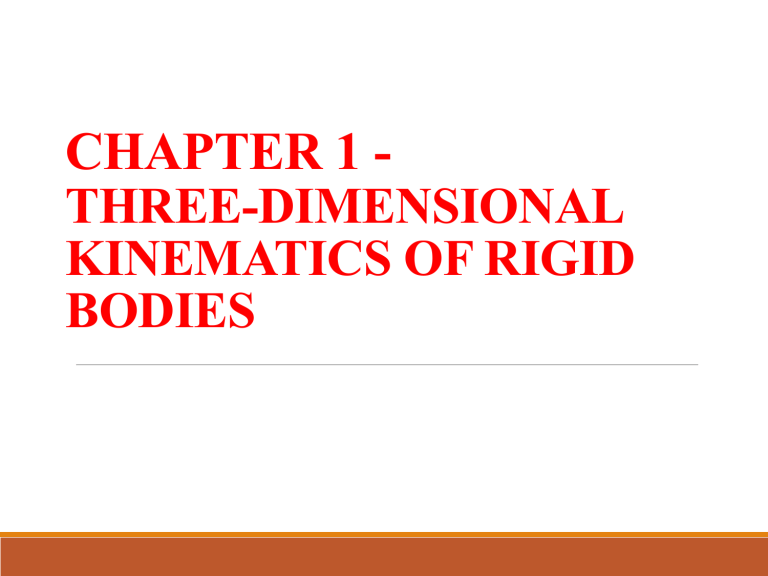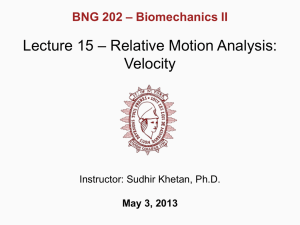
CHAPTER 1 THREE-DIMENSIONAL
KINEMATICS OF RIGID
BODIES
Machines
!
Foil & Stretch Rewinding Machine
Crane…..
Helicopter Swash Plate
Machines !
Machines !
Can You Name A Few …
Cams vs. gears vs. belts vs. pulleys
vs. kinematic chains vs. etc.
I have belt mechanisms
to move my legs, so I’m
faster and cheaper than
you!
Maybe, but since I have gear train
mechanisms my movements are
more precise and require less
power from my motors!
Why are we studying the mechanics of
machine and mechanisms?
So that you can understand machines and
one day you can design something which
is better that the ….
..or automate a process like this one
Parallel robot
Why are we studying mechanisms?
In time, perhaps even ….
But …..
We have to start at the beginning …
Kinematics and Dynamics
Dynamics, in physics,
dynamics refers to the
effects of forces on the
motion of objects
Kinematics is a branch of physics which describes
the motion of objects without consideration of the
circumstances leading to the motion. An example is
the prediction of centripetal force in uniform circular
motion, regardless of whether the circular path is
due to gravitational attraction, a banked curve on a
highway, or an attached string.
Kinetics a branch of
dynamics, concerned
with what motions of
bodies are produced
under the action of
particular forces (or
affect the motion). Not to
be confused with
kinematics, the study of
what forces are implied
by selected motions.
Kinematics and Dynamics
Kinematics
◦ Study of Motion and how to achieve a desired motion.
◦ Move an object from point A to point B along some path (having a
potential translation and rotation combination).
Rotation
A
B
Translation
Kinematics and Dynamics
◦ Mechanism design w.r.t. kinematics also deals with velocities, size,
shape, weight, etc. These parameters might be the inputs to the
mechanism design process (which will affect the final outcome of the mechanism
design: type, configuration, etc.).
v=?
Plot the velocity
profile of the
follower ?
q1 = ?
vz
q2 = ?
v=?
q=?
t
Kinematics and Kinetics
Kinetics
◦ Study of Forces and machine behaviour under forces and
how to use them in the design of mechanisms.
You need to know “Statics” and “Dynamics” !
PLANAR RIGID BODY MOTION
There are three types of planar rigid body motion.
PLANAR RIGID BODY MOTION
(continued)
Translation: Translation occurs if every line segment on
the body remains parallel to its original direction during
the motion. When all points move along straight lines,
the motion is called rectilinear translation. When the
paths of motion are curved lines, the motion is called
curvilinear translation.
PLANAR RIGID BODY MOTION
(continued)
Rotation about a fixed axis: In this case,
all the particles of the body, except those
on the axis of rotation, move along
circular paths in planes perpendicular to
the axis of rotation.
General plane motion: In this case,
the body undergoes both translation
and rotation. Translation occurs
within a plane and rotation occurs
about an axis perpendicular to this
plane.
PLANAR RIGID BODY MOTION
(continued)
An example of bodies
undergoing the three
types of motion is
shown in this
mechanism.
The wheel and crank undergo rotation about a fixed axis. In this case, both
axes of rotation are at the location of the pins and perpendicular to the
plane of the figure.
The piston undergoes rectilinear translation since it is constrained to slide
in a straight line.
The connecting rod undergoes curvilinear translation, since
it will remain horizontal as it moves along a circular path.
The connecting rod undergoes general plane motion, as it
will both translate and rotate.
Rotation About a Fixed Point
Euler's Theorem. Euler's theorem states that two
"component“ rotations about different axes passing
through a point are equivalent to a single resultant
rotation about an axis passing through the point. If
more than two rotations are applied, they can be
combined into pairs, and each pair can be further
reduced and combined into one rotation.
Finite Rotations. finite rotations do not obey the
commutative law of addition ϴ1 + ϴ 2 ≠ ϴ2 + ϴ1, they
cannot be classified as vectors
Angular Velocity. If the body is subjected to an angular
rotation dϴ about a fixed point, the angular velocity of the
body is defined by the time derivative,
The line specifying the direction
of w, which is collinear with dϴ,
is referred to as the instantaneous
axis of rotation
Angular Acceleration . The body's angular acceleration is
determined from the time derivative of its angular velocity. For
motion about a fixed point, a must account for a change in both
the magnitude and direction of w, so that, in general, a is not
directed along the instantaneous axis of rotation.
Velocity. Once w is specified, the velocity of any
point on a body rotating about a fixed point can
be determined using the same methods as for a
body rotating about a fixed axis. Hence, by the
cross product,
v=ωxr
Here r defines the position of the point measured
from the fixed point 0,
Acceleration . If ω and α are known at a
given instant, the acceleration of a point
can be obtained from the time derivative
of
a = α x r + ω x (ω x r)
The Time Derivative of a Vector Measured from
Either a Fixed or Translating-Rotating System
ω using a coordinate system that has a rotation defined by one
or more of the components of ω
ω = ωs + ωP
it will be convenient to express vector A in terms of its i, j, k
components, which define the directions of the moving axes
A = Ax i + Ay j + Az k
time derivative of A
time derivative of A of reference, is taken with respect to the
fixed frame the directions of i, j, and k change only on account of
the rotation n of the axes and not their translation
time derivatives of the unit vectors will now
be considered. For example, i = di/ dt
represents only the change in the direction
of i with respect to time, since i always has
a magnitude of 1 unit. As shown in Fig. the
change, di, is tangent to the path described
by the arrowhead of i as i swings due to the
rotation Ω. Accounting for both the
magnitude and direction of di, we can
therefore define i using the cross product,
Example 1
The disk shown spins about its axle with a constant angular velocity
ωs = 3 rad/s, while the horizontal platform on which the disk is
mounted rotates about the vertical axis at a constant rate ωp = 1
rad/s. Determine the angular acceleration of the disk and the
velocity and acceleration of point A on the disk when it is in the
position shown.
Solution
ω = ωs + ωp = {3j – l k} rad/s
= 0 + (-1 k) x ( 3 j ) = { 3 i } rad/s2
=0+0=0
rA = { l j + 0.25k }
VA = W x rA = (3j – l k) x (l j + 0.25 k) = {1.75 i} m/s
aA = α x rA + ω x (ω x rA )
= (3i) x (l j + 0.25 k) + (3 j – l k) x
[(3 j – l k) x (l j + 0.25 k)]
= {-2.50 j - 2.25 k} m/s2
GENERAL MOTION
The kinematic analysis of a rigid body which has general threedimensional motion is best accomplish with the aid of principles of relative
motion.
VB/A = ω X rB/A
aB/A = α x rB/A + ω x (ω x rB/A)
VB = VA + VB/A
aB = aA + aB/A
VB = VA + ω X rB/A
aB = aA + α x rB/A + ω x (ω x rB/A)
Example 2
If the collar at C moves towards B with a speed of 3 m/s, determine
the velocity of the collar at D and the angular velocity of the bar at
the instant shown. The bar is connected to the collars at its end
points by ball-and-socket joints.
Solution
VD = Vc + ω x r D/C
VD = -VD k
Vc = { 3j } m/s
rD/C = {l i + 2 j - 0.5 k} m
ω = ωx i + ωy j + ωz k
-0.5 ω y - 2 ω z = 0
0.5 ω x + 1 ω z + 3 = 0
2 ω x - 1 ω y + VD = 0
ω · rD/C = (ω x i + ω y j + ω z k) · (l i + 2 j - 0.5 k) = 0
1ωx + 2ωy - O.5ωz = 0
ωx = -4.86 rad/s , ωy = 2.29 rad/s ,
ωz = -0.571 rad/s
VD = 12.0 m/s
Relative-Motion Analysis Using Translating and
Rotating Axes
Position. If the position of "B with respect
to A" is specified by the relative-position
vector r B/A Fig., then, by vector addition
rB = rA + r B/A
Velocity. The velocity of point B measured from X, Y, Z can be
determined by taking the time derivative of
Acceleration. The acceleration of point B measured from
X, Y, Z is determined by taking the time derivative
Example 3
A motor and attached rod AB have the angular motions shown
below. A collar C on the rod is located 0.25 m from A and is
moving downward along the rod with a velocity of 3 m/s and an
acceleration of 2 m/s2. Determine the velocity and acceleration of
C at this instant.
Kinematic Equations.
Vc = vA + Ω X rC/A + (VC/A )xyz
Motion of A.
Ω ' = ωp
Ω = ωp = {5k} rad/s
[0 + 0] + 2k x 2i + 5k x 10j = {-50i + 4j} m/s2
Motion of C with Respect to A.
Ω" = Ωxyz = ωM
Ωxyz = ωM = {3i} rad/s
(rC/A)xyz = {-0.25k} m
= -3k + [3i x (-0.25k)] = {0.75j - 3k} m/s
= [-2k + 3i x (-3k)] + (li) x (-0.25k) + (3i) x (0.75j - 3k)
= {18.25 j + 0.25 k} m/s2
Motion of C
Vc = VA + Ω x rC/A + (VC/A )xyz
= 10 j + [5 k x (-0.25 k)] + (0.75 j – 3 k)
= {10.75j - 3k} m/s
= (-50i + 4j ) + [2k x (-0.25k )] + 5k x [5k x (-0.25k)]
+ 2[5k x (0.75j - 3k)] + (18.25j + O.25k)
= {-57.5i + 22.25j + 0.25k} m/s2



